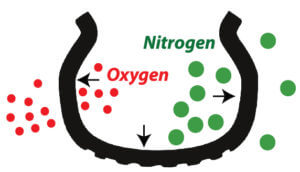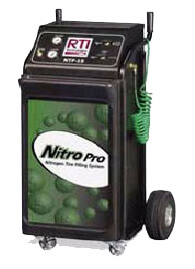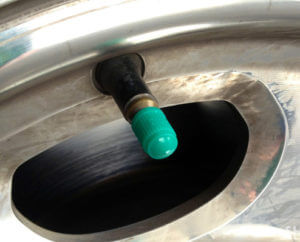Nitrogen versus air filled tires
Is it worth it to fill with nitrogen versus air filled tires?
Many shops offer to fill tires with nitrogen versus air filled tires. This is based on the fact that tires loose less pressure when filled with nitrogen. If the shop is offering a nitrogen fill for free, fine. But it’s not worth paying for it.
Why is nitrogen better than air?
All tires have microscopic pores that allow pressurized gas to escape over time,

Nitrogen molecules are larger, providing a lower permeation rate than air
resulting in under inflation. Under inflation causes accelerated tire wear, reduces traction (less tread in contact with the road surface), and reduced gas mileage.
Nitrogen has larger molecules than oxygen, argon, and carbon dioxide; the other gases found in outside air. So you’ll lose less pressure with nirogen versus air filled tires.
Recent tests conducted by the Mechanical Engineering Department at Clemson University prove that filling tires with dry nitrogen can improve tire life and fuel economy.
The results show that in a nirogen versus air filled tire scenario, nitrogen maintains tire pressure 74% better than compressed air from a shop’s air compressor. Plus, nitrogen filled tires had 70% less rolling resistance than air filled tires. Finally, nitrogen filled tires last longer because pure nitrogen eliminates rubber oxidation inside the tire, which is normally caused by compressed air containing oxygen.
Dried nitrogen also reduces pressure variation
Dried outside air contains 78.09% nitrogen, 20.95% oxygen, 0.93% argon, 0.04% carbon dioxide, and small amounts of other gases, as well as water vapor. But air from a shop’s air compressor isn’t dry. If fact, the amount of water vapor in a shop’s air compressor is directly related to the air’s relative humidity and temperature when the compressor is operating. If the shop’s air compressor is filling its holding tank on a hot humid day, the compressed air will have a higher water vapor level. Some of that moisture condenses on the colder sides of the air tank and settles to the bottom of the tank, but the amount of condensation depends on the ambient temperature in the shop and how long the compressor runs. The air compressor itself heats the air, increasing the tank temperature. The increased tank temperature reduces reducing condensation, allowing more moisture retention in the air.
Water laden air inside a tire causes the tire’s air pressure to fluctuate greatly as ambient and the tire’s driving temperatures change. So inflating with a dried gas offers substantial benefits in maintaining the proper air pressure in a tire. In summary:
Filling tires with nitrogen versus air provides the following benefits
• Less tire pressure loss over time, resulting in less tire wear due to under inflation
• Better fuel mileage due to lower rolling resistance and proper tire pressure
• Less variation in tire pressure caused by water vapor
• Longer tire life due to lower oxidation levels inside the tire
What are the downsides of filling tires with nitrogen versus air?
• Lack of nitrogen infrastructure. Note that although nitrogen reduces gas permeation

Most shops don’t have a nitrogen machine. Fill your tires with regular compressed air and you negate all the advantages of a nitrogen fill
through the rubber, it doesn’t eliminate it. So you still have to check tire pressures on a regular basis and refill with pure dried nitrogen. Since most shops don’t provide pure dry nitrogen, you’ll have to fill your tires at a shop that provides that service.
• Topping off with compressed air completely negates the advantages of nitrogen. If your tires are low and you add compressed air, all the advantages of the

Nitrogen filled tires must have a green valve stem cap for identification
nitrogen fill are lost. To regain the pure nitrogen fill, the tire must be completely purged and refilled with pure dried nitrogen.
In summary; once you start with pure dried nitrogen, you are married to nitrogen providers from that point on. You must still check your tire pressure and you must fill with pure dried nitrogen.
In other words, although nitrogen versus air offers significant advantages in theory, it doesn’t work well in the real world.
GM’s Position on the Use of Nitrogen Gas in Tires
“General Motors does not oppose the use of purified nitrogen as an inflation gas for tires. We expect the theoretical benefits to be reduced in practical use due to the lack of an existing infrastructure to continuously facilitate inflating tires with nearly pure nitrogen. Even occasional inflation with compressed atmospheric air will negate many of the theoretical benefits. Given those theoretical benefits, practical limitations, and the robust design of GM original equipment TPC tires, the realized benefits to our customer of inflating their tires with purified nitrogen are expected to be minimal.” GM service bulletin #05-03-10-020D
How and when to check tire air pressure
©, 2017 Rick Muscoplat
Posted on by Rick Muscoplat
